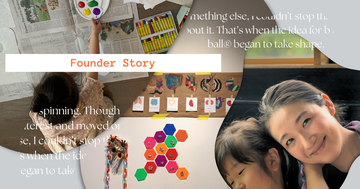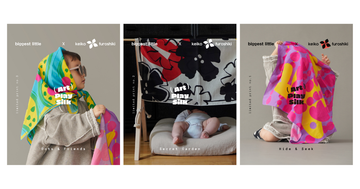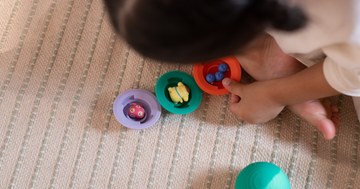Why I Created b is for ball®: The Story Behind the Ball
Today is my mother’s birthday. It’s also the day I launched my little baby, b is for ball®, into the world two years ago. It’s been a whirlwind, and honestly, I rarely have time to slow down and reflect. But today, I want to take a moment to share my story.
I'd like to start with a moment I remember quite vividly: sitting in the living room, where every inch of space was covered with toys. My 6-month-old was inching toward her favorite toy, the vacuum, after my toddler’s sudden scream scared her away in protection of her fragile Magnatile tower. Meanwhile, her baby piano in the corner blared the same song for the hundredth time. Shocked by the scream and just having mediated the tenth conflict between them, I remember feeling depleted and having this deep desire for peace, wishing I could just throw it all away. That was the moment I knew something had to change.
From Naive First-Time Parent to Intentional Living
A little background—before my second child was born, I left my finance job to become a dedicated “educator” for my first. I dove into books on early childhood discipline, applying what I learned at home. Ever since she was one, gifts from friends or plastic toys I had bought based on glowing reviews slowly got tucked away into storage. But when my second child was born, I unearthed all those toys. My first was immediately drawn to them, distracted by the flashing lights and buttons, moving toys from one hiding spot to another. At first, it seemed harmless. But soon, it led to that exact moment...
As I sat back and observed, I had an epiphany: my 3-year-old wasn’t really playing with the toys. She was just pressing buttons, jumping from one toy to the next, never truly engaged. That’s not play—that’s dabbling. And the worst part? It slowly became a habit. I could see how one child would parade through the toy chaos, whining, “I’m bored.”
At the same time, I was nearing burnout. Between cleaning, policing the mess, and feeling misaligned, the joy I once felt in spending time with my first child was slowly slipping away.
My gut screamed for intervention, and I had reached my breaking point. I made a decision: Let’s go minimal. Let’s get rid of all the unnecessary stuff and noise and see what happens.
Nearly 2 Years of Minimalistic Living
That year became a turning point—a time where I saw my kids begin to play in a completely different way. With fewer toys, we had more space—physically and mentally. My 3-year-old, who had always been a sweet whirlwind, started playing with such focus and creativity. With just a handful of open-ended toys and everyday household items, we found ourselves creating entire worlds out of toilet paper rolls, arts and crafts she brought home from school, newspapers, and Amazon boxes.

Having toys—or not having toys—was no longer part of the discussion. We made space for deeper connections. We would discuss the million questions she asked, read books about the moon, and search for materials to make our own moon models. We followed up with questions about where the moon was, then went off to find materials to demonstrate its relationship to Earth. This is just one example. We made space for conversation, experimentation, and curiosity to flow naturally.

I began to realize how much joy we were both having—talking, creating, and learning together. Even though my 1-year-old still needed safe, simple items for exploration, the shift in our home made me feel free to think, observe, and really see my experience as a parent. The space I had from constant cleanup allowed me to reflect deeply and gain clarity.
It became clear to me that children don’t need an overwhelming number of toys. It truly felt like toys—or no toys—were just tools to help them learn. They need tools that allow them to fulfill their curiosity, explore, create, and tell their own stories.
A Conversation at the Playground
But here’s the thing: it wasn’t my idea to create a toy. In fact, the inspiration came from a conversation with my older child.
Around the summer of 2020, when it was safe to go outside a little bit, we went to the playground. My older one, who was still little, got scared by a water gun shaped like a rifle. We sat down on the park bench, and I asked her what we could invent as a new water toy. She got so excited, describing a solution I could barely understand. Then, she drew her “invention”—a design that looked like a cross between a rocket ship and a French press.
My brain started spinning. Though she quickly lost interest and moved on to something else, I couldn’t stop thinking about it. That’s when the idea for b is for ball® began to take shape.
A Symbol of Simplicity and Joy
Three years later, b is for ball® was born. Originally, it was intended to be a better solution for water and bath toys. But through observing play patterns in children—especially my own—I realized that I didn’t want to create just another toy. I wanted it to be an open-ended tool. Open-ended toys allow kids to manipulate them in countless ways, and children are masters at turning undefined objects into limitless possibilities.
b is for ball® is a reflection of everything we’ve learned along the way—the value of less, the power of imagination, and the importance of slowing down and really engaging with our kids.
So, when you hold b is for ball® in your hands, I hope it gives you the power to trust that your child already has what it takes to learn on their own—with a little bit of help.
The journey of creating b is for ball® has been a deeply personal one, and I’m so grateful to see it come to life. My hope is that through this product, you’ll find inspiration to engage with your child in a way that fosters meaningful moments, encourages creativity, and opens up endless possibilities for play.
Yours Truly,
Stephanie




